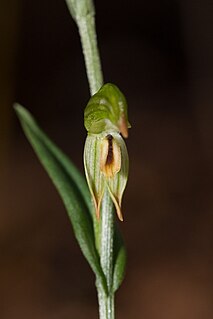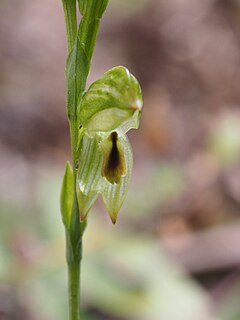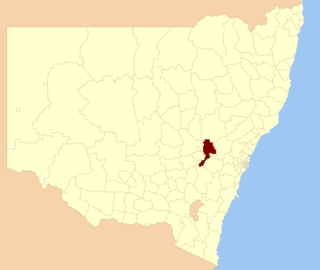
Pterostylis melagramma, commonly known as the black-stripe leafy greenhood is a plant in the orchid family Orchidaceae and is endemic to south-eastern Australia. Individual plants have either a rosette of three to six leaves or a flowering spike with up to twenty flowers and five to seven stem leaves. The flowers are translucent green with faint darker green lines and have a brownish-yellow labellum with a dark stripe.

Pterostylis chlorogramma, commonly known as the green-striped leafy greenhood, is a plant in the orchid family Orchidaceae and is endemic to Victoria. Flowering plants have up to seven translucent green flowers with darker green stripes. The flowers have a green labellum with a darker stripe down the middle. Non-flowering plants have a rosette of leaves on a short, thin stalk but flowering plants lack the rosette, instead having five to seven stem leaves.

Pterostylis diminuta, commonly known as the small-flowered leafy greenhood, is a plant in the orchid family Orchidaceae and is endemic to Victoria. As with similar greenhoods, the flowering plants differ from those which are not flowering. The non-flowering plants have a rosette of leaves flat on the ground but the flowering plants have up to twelve small, partly green, partly translucent flowers and lack a rosette.

Pterostylis macilenta is a plant in the orchid family Orchidaceae and is endemic to the Grampians National Park in Victoria. As with similar greenhoods, the flowering plants differ from those which are not flowering. The non-flowering plants have a rosette of leaves flat on the ground but the flowering plants have up to six translucent, dark green flowers and lack a rosette.

Pterostylis williamsonii, commonly known as the brown-lip leafy greenhood, is a plant in the orchid family Orchidaceae and is endemic to Tasmania. Flowering plants have up to seven transparent green flowers with darker green and brown bands and a hairy, insect-like labellum with a blackish stripe. Non-flowering plants have a rosette of leaves on a short stalk but flowering plants lack the rosette, instead having five to seven stem leaves.

Pterostylis jonesii, commonly known as the montane leafy greenhood, is a plant in the orchid family Orchidaceae and is endemic to a small area of south-eastern Australia. Individual plants have either a rosette of three to six leaves or a flowering spike with up to eleven flowers and five to seven stem leaves. The flowers are translucent green with faint darker green lines and have a brownish-yellow labellum with a dark stripe.

Pterostylis barringtonensis, commonly known as the Barrington leafy greenhood, is a plant in the orchid family Orchidaceae and is endemic to New South Wales. As with similar greenhoods, the flowering plants differ from those which are not flowering. The non-flowering plants have a rosette of leaves on a short stalk but the flowering plants lack a rosette and have up to seven dark green flowers on a flowering stem with stem leaves. It is only known from Barrington Tops.
Pterostylis crassa, commonly known as the coarse leafy greenhood, is a plant in the orchid family Orchidaceae and is endemic to Victoria. As with similar greenhoods, plants in flower differ from those that are not. Those not in flower have a rosette of leaves on a short stalk but when flowering, plants have up to four relatively large, shiny dark green translucent flowers on a flowering stem with stem leaves.
Pterostylis chocolatina, commonly known as the chocolate-lip leafy greenhood, is a plant in the orchid family Orchidaceae and is endemic to New South Wales. As with similar greenhoods, plants in flower differ from those that are not. Plants not in flower have a rosette of leaves on a short stalk, but when in flower, plants lack a rosette and have up to thirteen green flowers on a flowering stem with stem leaves. The labellum is dark brown with a blackish lump near its base.
Pterostylis lineata, commonly known as the Blue Mountains leafy greenhood, is a plant in the orchid family Orchidaceae and is endemic to New South Wales. As with similar greenhoods, the flowering plants differ from those which are not flowering. The non-flowering plants have a rosette of leaves on a short stalk but the flowering plants lack a rosette and have up to seven dark green flowers with translucent "windows" on a flowering stem with stem leaves. The labellum is light brown with a black strip along its mid-line.
Pterostylis littoralis, commonly known as the coastal leafy greenhood, is a plant in the orchid family Orchidaceae and is endemic to South Australia. Flowering plants have up to five pale green flowers with darker green stripes and brownish tips. The flowers have a narrow, pale green labellum. Non-flowering plants have a rosette of leaves on a short, thin stalk but flowering plants lack the rosette, instead having four or five stem leaves.
Pterostylis loganii, commonly known as the Logan's leafy greenhood, is a plant in the orchid family Orchidaceae and is endemic to a small area near the border between New South Wales and Victoria. Flowering plants have up to five pale green flowers with darker green stripes and brownish tips. The flowers have a brown labellum with a blackish stripe and a blackish mound near its base. Non-flowering plants have a rosette of leaves on a short, thin stalk but flowering plants lack the rosette, instead having five to seven stem leaves.
Pterostylis macrosepala is a plant in the orchid family Orchidaceae and is endemic to New South Wales where it grows on the central-west slopes. As with similar greenhoods, the flowering plants differ from those which are not flowering. The non-flowering plants have a rosette of leaves flat on the ground but the flowering plants have up to eight translucent green flowers with narrow, dark green stripes and up to ten stem leaves.
Pterostylis parca commonly known as the Lithgow leafy greenhood is a plant in the orchid family Orchidaceae and is endemic to New South Wales. Non-flowering plants have a rosette of leaves on a short stalk. Flowering plants lack a rosette but have up to eight translucent pale green flowers on a flowering stem with three to six stem leaves.

Pterostylis prasina, commonly known as the mallee leafy greenhood, is a plant in the orchid family Orchidaceae and is endemic to southern continental Australia. Non-flowering have a rosette of leaves on a short stalk, but flowering plants lack the rosette and have up to eight pale green and translucent green flowers with darker green lines. The flowers have a pale green labellum with a darker central line. It is a common and widespread greenhood in parts of Victoria and South Australia.
Pterostylis stenosepala, commonly known as the narrow-sepalled leafy greenhood, is a plant in the orchid family Orchidaceae and is endemic to New South Wales. Flowering plants have up to six shiny, translucent green flowers with darker green stripes. The flowers have an insect-like labellum which is green with a dark green mound on its upper end. Non-flowering plants have a rosette of leaves on a stalk, but flowering plants lack the rosette, instead having between four and eight stem leaves.

Pterostylis umbrina, commonly known as the broad-sepaled leafy greenhood, is a plant in the orchid family Orchidaceae and is endemic to the Australian Capital Territory and New South Wales on the Southern Tablelands. As with similar greenhoods, plants in flower differ from those that are not. Those not in flower have a rosette of leaves flat on a short stalk. Plants in flower have up to six green flowers with darker green stripes with stem leaves but lack a rosette.
Pterostylis viriosa, commonly known as the Adelaide Hills banded greenhood, is a plant in the orchid family Orchidaceae and is endemic to South Australia. Flowering plants have up several green flowers with faint white stripes. The flowers have an insect-like labellum which is green with a dark green mound on its upper end. Non-flowering plants have a rosette of leaves on a stalk, but flowering plants lack the rosette, instead having several stem leaves.
Pterostylis vitrea commonly known as the glassy leafy greenhood is a plant in the orchid family Orchidaceae and is endemic to Queensland. Non-flowering plants have a rosette of leaves on a short stalk. Flowering plants lack a rosette but have up to seven translucent green flowers with darker green lines on a flowering stem with between five and seven stem leaves.
Pterostylis flavovirens, commonly known as the coastal banded greenhood, is a plant in the orchid family Orchidaceae that is endemic to South Australia. As with other similar orchids, non-flowering plants differ from those in flower. Flowering plants have up to seven pale to translucent green flowers with darker green stripes. The flowers have an insect-like labellum which is yellowish green with a slightly darker green stripe along its centre. Non-flowering plants have a rosette of leaves on a stalk, but flowering plants lack the rosette, instead having three to six stem leaves.

















